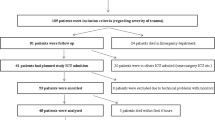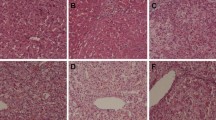Abstract
This study was aimed at clarifying the usefulness of the arterial ketone body ratio (AKBR), which reflects hepatic mitochondrial redox state and closely correlates with hepatic energy production, for understanding the degree of hepatic mitochondrial damage and the extent of the deterioration in hepatic energy metabolism during of shortly after hemorrhagic shock. Changes in the AKBR of 33 trauma victims who were admitted to our institute in hemorrhagic shock with a systolic pressure lower than 70 mmHg were measured until the patient recovered with the restoration of AKBR to the normal range (≥ 1.0) or until the patient died. During hemorrhagic shock the AKBRs were highly decreased, indicating deteriorated hepatic function. With successive fluid resuscitation the AKBR quickly recovered in 15 surviving patients from an initial value of 0.26±0.03 toward normal within hours, indicating that hepatic mitochondria are functioning normally. The AKBR recovered to a normal value of 1.10±0.06 on day 2 (p<0.001). In 18 expired patients, AKBR did not recover to normal range, even though some of the patients recovered from the shock state. On the other hand, AST, ALT, LDH, and prothrombin time on day 2 were not significantly different from the values on admission, and the changes during the interval were not unidirectional even in the surviving patients, providing no information on the current functional state of the liver. Measurement of AKBR during and shortly after hemorrhagic shock provides timely and accurate information about liver function.
Résumé
Le but de cette étude a été de clarifier l'utilité du taux des corps cétoniques dans le sang artériel (CCA). Le CCA est considéré comme un reflet fidèle de l'état rédox des mitochondries hépatiques et est étroitement corrélé avec la production d'énergie hépatique, et permet de préciser l'étendue des lésions des mitochondries hépatiques et l'importance de la dégradadation du métabolisme pendant ou après le choc hémorragique. On a mesuré le CCA chez 33 patients ayant un choc hémorragique caractérisé par une pression systolique inféricure à 75 mm Hg, depuis Farrivée jusqu'à ce que le CCA se normalise (≥ 1.0) ou que le patient dècède. Lors du choc, le CCA était très diminué, témoignant d'une détérioration de la fonction hépatique. Chez les 15 patients survivants, après remplissage, les valeurs de CCA augmentaient à partir des valeurs initiales de 0.26±0.03 vers des valeurs normales, en quelques heures seulement, passant à 1.10±0.06 au J2 (p<0.001), indiquant que les mitochondrie hépatiques étaient intactes. Chez les 18 patients décédés, cependant, le CCA n'a pas atteint les valeurs normales, même lorsque le patient n'était plus en état de choc. En revanche, les valeurs des transaminases AST, ALT, des LDII et du taux de prothrombine à J2 ne différaient pas beaucoup des valeurs à l'admission. Les changements pendant l'intervalle n'était pas unidirectionnels même chez les patients survivants, sans que l'on sache très bien l'état fonctionnel du foie. Mesurer les valeurs de CCA pendant et après un choc hémorragique procure des enseignements importants et précis sur la fonction hépatique.
Resumen
El presente estudio está orientado a definir la utilidad de la relación de cuerpos cetónicos (arterial ketone body ratio, AKBR), la cual refleja el estado redox de la mitocondria hepática y se correlaciona íntimamente con la producción hepática de energía, para la comprensión del grado de lesión mitocóndrica hepática y de la gravedad del deterioro en el metabolismo energético hepático durante, o poco después del shock hemorrágico. Se determinaron los cambios en la AKBR en 33 pacientes de trauma hospitalizados en estado de shock hemorrágico con presiones sistólicas menores de 75 mmHg hasta su recuperación con restablecimiento de la AKBR a niveles normales (>-1.0), o hasta la muerte. En el curso del shock hemorrágico, la AKBR apareció notoriamente disminuida, hallazgo indicativo de función hepática deteriorada. Con la resucitación con líquidos parenterales, la AKBR rápidamente se recuperó en 15 sobrevivientes, desde su valor inicial de 0.26±0.03 hasta el valor normal en el curso de horas, lo cual indicaba que las mitocondrias hepáticas se hallaban functionando normalmente. La AKBR se recuperó al valor normal de 1.10±0.06 en el día dos (p<0.001). Por el contrario, en 18 pacientes que expiraron, la AKBR no retornó a valores normales aunque algunos de ellos en algún momento se recuperaron del estado de shock. Por otra parte, en el día dos la AST, ALT, LDH y el tiempo de protrombina no se encontraron significativamente diferentes de los valores registrados en la admisión y lo cambios ocurridos en el intervalo no fueron unidireccionales aún en los sobrevivientes, lo cual no aportó información sobre el estado funcional del hígado. La medición de ASKBR durante, o poco después del shock hemorrágico, provee información oportuna y certera de la función hepática.
Similar content being viewed by others
References
Shimahara, Y., Ozawa, K., Ida, T., Ukikusa, M., Tobe, T.: Four stages of mitochondrial deterioration in hemorrhagic shock. Res. Exp. Med. 179:23, 1981
Ozawa, K., Ida, T., Kamano, T., Garbus, J., Cowley, R.A.: Different response of hepatic energy charge and adenine nucleotide concentrations to hemorrhagic shock. Res. Exp. Med. 169:145, 1976
Ozawa, K.: Energy metabolism. In Pathophysiology of Shock, Anoxia and Ischemia, R.A. Cowley, B.F. Trump, editors. Baltimore, Williams & Wilkins, 1981, pp. 74–83
Ozawa, K.: Biological significance of mitochondrial redox potential in shock and multiple organ failure—redox theory. Prog. Clin. Biol. Res. 111:39, 1983
Ozawa, K., Kamiyama, Y., Kimura, K.: Relation of mitochondrial redox potential to hepatic energy charge in animals with hepatectomy, jaundice, hemorrhage and sepsis as well as patients. Langenbecks Arch. Chir. 357:204, 1982
Yamamoto, M., Tanaka, J., Ozawa, K., Tobe, T.: Significance of acetoacetate/β-hydroxybutyrate ratio in arterial blood as an indicator of the severity of hemorrhagie shock. J. Surg. Res. 28:124, 1980
Ukikusa, M., Ida, T., Ozawa, K., Tobe, T.: The influence of hypoxia and hemorrhage upon adenylate energy charge and bile flow. Surg. Gynecol. Obstet. 149:346, 1979
Wallenstein, S., Zucker, C.L., Fleiss, J.: Some statistical methods useful in circulation research. Circ. Shock 8:503, 1981
Pettit, F.H., Pelley, J.W., Reed, L.J.: Regulation of pyruvate dehydrogenase kinase and phosphatase by acetyl-CoA/CoA and NADH/NAD ratio. Biochem. Biophy. Res. Commun. 65:575, 1975
Williamson, D.H., Lund, P., Krebs, H.A.: The redox state of free nicotinamide-adenine dinucleotide in the cytoplasm and mitochondria of rat liver. Biochem. J. 103:514, 1967
Wilson, D.F., Stubbs, M., Veech, R.L., Erecinska, M., Krebs, H.A.: Equilibrium relations between the oxidation-reduction relations and the adenosine triphosphate synthesis in suspensions of isolated liver cells. Biochem. J. 140:57, 1974
Davies, A.O., Samuelson, W.M.: Nonequilibrium of two redox couplets in human plasma: lactate-pyruvate and beta-hydroxybutyrate-acetoacetate. Crit. Care Med. 14:936, 1986
Davies, A.O., Samuelson, W.M.: Assessing redox status in human plasma: experience in critically ill patients. Crit. Care Med. 14:942 1986
Ukikusa, M., Ozawa, K., Shimahara, Y., Asano, M., Nakatani, T., Tobe, T: Changes in blood ketone body ratio: their significance after major hepatic resection. Arch. Surg. 116:781, 1981
Ikai, I., Shimahara, Y., Wakashiro, S., et al.: Influence of hemorrhagic shock on hepatic energy metabolism in carbon tetrachloride induced cirrhotic rats. Circ. Shock 26:365, 1988
Author information
Authors and Affiliations
Rights and permissions
About this article
Cite this article
Nakatani, T., Spolter, L. & Kobayashi, K. Arterial ketone body ratio as a parameter of hepatic mitochondrial redox state during and after hemorrhagic shock. World J. Surg. 19, 592–596 (1995). https://doi.org/10.1007/BF00294729
Issue Date:
DOI: https://doi.org/10.1007/BF00294729




